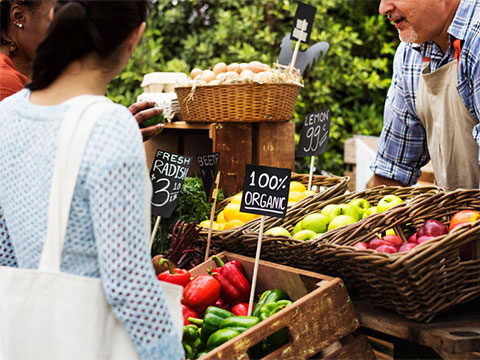Deadly Harvest
- By Elisabeth Flynn
- Reading Time: 7 mins.
 The Farm-to-Table movement of the last decade has celebrated local farmers and their rural lifestyle. Sustainable farming is a wholesome and noble occupation that provides nutritious whole foods to an often urban clientele hungry for authenticity and health.
The Farm-to-Table movement of the last decade has celebrated local farmers and their rural lifestyle. Sustainable farming is a wholesome and noble occupation that provides nutritious whole foods to an often urban clientele hungry for authenticity and health.
Farming is a demanding and difficult calling that provides beauty and independence but also requires plenty of sacrifices: long hours, little time off, isolation, and usually razor-thin operating margins and thus frequent financial instability. Farms are often at risk of going out of business if a serious illness occurs in the family, bad weather wipes out a harvest or two, or market prices fluctuate.
And there is another risk for U.S. farmers: death by suicide. Rural farmers and agricultural workers top the list of people who take their own lives, according to a 2016 study by the Centers for Disease Control (CDC).* The incidence is more than double the rate of military veterans. Why?
Behind the Numbers
Dr. Michael Rosmann, one of the country’s leading experts in the area of mental health among agricultural workers, has been studying this issue for decades. A psychologist by training, and a working farmer in Iowa since 1979, Rosmann saw firsthand the devastating impact of the 1980s farm crisis, when a massive economic downturn led to record farm foreclosure rates and a subsequent spike in suicide among farmers.
Even in times of relative economic stability, disparate rates of rural suicide persist. Rosmann cites an analysis of suicide data in the U.S. from 1970 to 1997 by G. K. Singh and M. Siahpush, published in the American Journal of Public Health, which confirmed what he and some others had suspected: “The rate of suicide in the most rural areas where farmers live is about 60 percent higher than for the most urban areas of the U.S.”
Rosmann and others—including the CDC—list various sources of stress for people engaged in farming, with economic pressure (fear of losing the family farm) and the loss of a child in a farming incident among the most significant.
Compounding the financial pressures are numerous factors beyond the farmer’s control, such as unpredictable weather, falling market prices, and labor shortages.
The social isolation experienced by many farmers, the intensive nature of their work, the difficulty of taking time off, and pesticide exposure are other factors. “Previous research suggests that farmers’ chronic exposure to pesticides might affect the neurologic system and contribute to depressive symptoms. Other factors that might contribute to suicide among farmers include social isolation, the potential for financial losses, barriers to and unwillingness to seek mental health services (which might be limited in rural areas), and access to lethal means,” notes the 2016 CDC study, which was based on 2012 data from 17 states.
Knesha Rose-Davison, MPH, is the health communications director of the AgriSafe Network, an Iowa-based nonprofit organization working to educate and connect healthcare providers and to reduce health disparities in the agricultural community.
“Many agricultural members live on the farms they manage, with workweeks that exceed 40 hours,” Rose-Davison explains. “Balancing an agricultural business while still prioritizing time with family, friends, or other passions can be difficult.”
Then there’s the question of access to health care—and its cost. Farmers typically provide their own health insurance, cutting into already tight profit margins, so every expense is keenly felt. “Rural areas often lack the breadth of health services that a typical urban area would have, which generally has rural community members going without crucial health services,” Rose-Davison says.
Underscoring this point, she cites a 2016 study by the National Rural Health Association (NHRA) showing nearly 700 rural hospitals at risk for closure, with 83 hospitals having closed since 2010. “This degree of hospital closure,” she notes, “puts millions of rural residents at risk of losing much-needed health-care services,” including mental health services.
On the individual level, Rose-Davison points to the “imposed sense of resilience and strength” that often characterizes farmers and the work they do. “Agricultural workers are often painted as the backbone of society,” she says, “and therefore represent an unyielding force that suffers backbreaking work to provide for others.”
But there’s a flip side to this culture of stoicism. “Suffering from depression or anxiety can be seen as weak,” Rose-Davidson says, “and accessing mental health services equally so.”
This gets back to something Michael Rosmann and others describe as the Agrarian Imperative: a drive to pursue the difficult work of producing and providing food for others, which is something most people who undertake farming, ranching, or related occupations possess. At times the pressure of that imperative may exacerbate feelings of failure—such as when economic survival is in question.
Help for Farmers
Mental health support and suicide prevention resources are available nationally, but clinicians need to be better educated in the unique stressors of agricultural work, says Rosmann. This is a big part of AgriSafe’s mission. Using web-based technology, he explains, they deliver critical training by experts in the field. AgriSafe also works to raise awareness of the public health threats farmers face through advocacy; education; state, national, and international affiliate arrangements; and social media campaigns.
Changes to certain aspects of farm financing in recent years have provided some relief, Rosmann notes. “Farmers now have crop insurance and some reimbursement for animal losses.” He adds that “the interest rates on borrowed money for land and farming inputs are much lower now than in the 1980s. Calling in loans is more humane than back then.”
At the same time, he notes that the U.S. is facing an era of “changing foreign trade policies” along with the overproduction of many agricultural goods and the imposition of tariffs that affect farm markets.
Rosmann continues to champion policy initiatives that would address the holistic health needs of farmers, including a proposed National Center for Agricultural Behavioral Health, which among other things would provide technical assistance to states and regions and secure funding to provide farm crisis services.
The current version of the Senate Farm Bill—which was sent to conference committee in July 2018, to work out differences with a House bill and return a single piece of legislation to both houses for a vote—would reauthorize the Farm and Ranch Stress Assistance Network (FRSAN), a mental health resources program established by the 2008 Farm Bill but never funded. If approved, it would allocate $10 million through 2023 for farm crisis services, “including hotlines, referrals, follow-up counseling similar to an EAP for 1 to 5 sessions and so that no insurance claims are necessary,” Rosmann explains.
In terms of further recommendations, Rose-Davison stresses the need for increasing public awareness around accessing mental health services and removing the stigma around counseling. Using technology such as live video calls, or “telehealth,” to address medical/health needs and providing mobile health clinics to regions that lack resources are other ways to build support.
Rosmann says he’s noticed an increased awareness regarding mental health among the farmers he works with. He describes farm and ranch owners and operators as well educated and among the most intelligent of any occupation, and he adds that “many agricultural producers read publications that are useful to them and want to be optimally able to carry out their life’s work. That means they have to be behaviorally healthy.”
How to Help

If you’re reading this from an office cubicle, miles away from the nearest farm, you may well be wondering what can I do about any of this?
Policy: Contact your state and federal representatives and urge them to promote policies and legislation that support farmers and sustainable agriculture. Beyond the Farm Bill legislation and macro-level policy reforms, Andrew Bahrenburg, national policy director of the National Young Farmers Coalition (NYFC), has this suggestion: “People working together to close the gap between farmer and consumer, that’s what’s needed now.”
Buy Local: On the individual level, this might involve making intentional choices about where you purchase your food, opting to buy from smaller, local, or regional farms and producers as often as possible—and eating food that’s in season in your area. The organization Sustainable Table provides guidance on seasonal eating, and writer-photographer Deb Perelman’s Smitten Kitchen blog on “fearless cooking from a tiny kitchen in New York City” is a great resource for urban dwellers. The Eat Well Guide has a searchable directory of more than 25,000 restaurants, farms, markets, and other places where you can find local, sustainable food. You might also lookup family farms within driving distance, and plan a weekend outing to purchase fresh food directly from a farm stand or “u-pick” operation.
Social Media: Give your local growers a shout-out on social media. More small farms are turning to these platforms to connect with new customers. Your posts and testimonials can help them get the word out.
Farmers First: Purchase produce from stores and vendors that put farmers first by paying fair wages for produce. Supporting small farms and sustainable farming lies at the heart of our mission at The FruitGuys, from our commitment to supporting local farms as our primary vendors to the nonprofit The FruitGuys Community Fund, which gives out annual sustainability grants to small farms. Volunteer remotely to help read through grant applications or spread the word to small farmers about the grants.
Making thoughtful choices about where you spend your food dollars is a powerful everyday action that is not only good for your own health but for farmers and the food economy as well.
Resources for Farmers
National Suicide Prevention Lifeline: 1-800-273-8255
FarmAid’s Farmer Resource Guides
The CDC’s regional Centers for Agricultural Safety & Health
*Editor’s Note: In June 2018, the CDC issued a retraction of its original 2016 statistics, citing “coding issues” with the data they had collected. In compiling their data for 2016, the agency counted farmers within “farming, fishing, and forestry” occupations, resulting in higher suicide rates for that category. In past years, farmers and ranchers had been considered in a separate occupational category of “managers.” The CDC has not offered a timeline for revising its data and acknowledges that it may or may not affect the final ranking of occupations. Regarding the CDC’s action, Dr. Rosmann said: “When all available data about suicide among the agricultural population is compiled together, it still says farmers (using the USDA definition) have a consistently high—and maybe the highest rate—of any occupational group.”
Elisabeth Flynn is a Philadelphia-based writer and editor and has spent the last 15 years working in the nonprofit/social innovation sector, including stints at the Philadelphia Museum of Art and Mazzoni Center, an LGBTQ-focused health and wellness provider.
Recent Articles
Subscribe to our Newsletter
"*" indicates required fields





